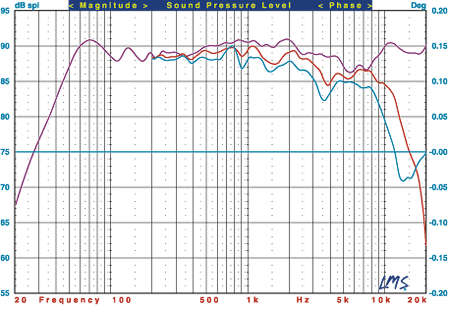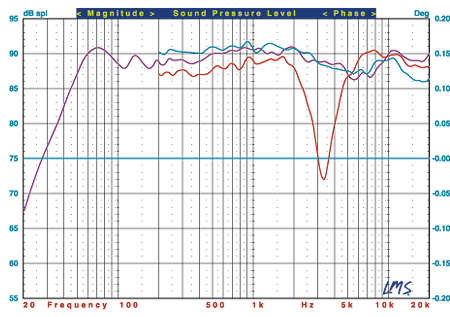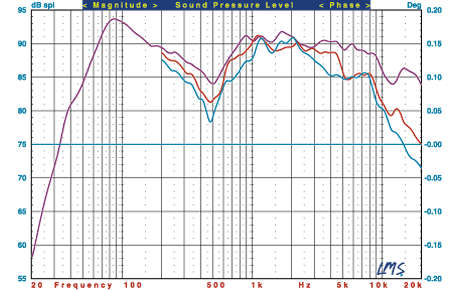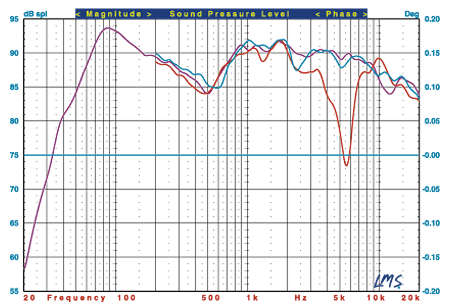Sonus Faber Cremona surround speaker system Measurements
The Cremona's bass port is tuned to approximately 30Hz. Its impedance magnitude is a minimum of 3ohms at both 98 and 137Hz, and remains below 4ohms from 75 to 240Hz. The impedance phase is more capacitive than normal between 50 and 100Hz; I would judge the speaker to be a moderately difficult load to drive, though it should be no challenge for an amplifier of the quality likely to be used with it. The specified nominal impedance rating of 4ohms is reasonable. The sensitivity measured 90dB/W/m across most of the frequency range.
The Cremona's front response is shown in Fig.1 (violet). This is the pseudo-anechoic response averaged across a 30° forward angle in the horizontal plane at tweeter height, combined with the nearfield responses of the woofers and bass port. The Cremona's measured effective lower limit (–10dB) was 37Hz relative to the output at 70Hz.

Fig.1
The overall averaged response in Fig.1 is impressively smooth from the lower-bass limit to the 20kHz limit of the measurements. A gentle +2-octave plateau in the response between 500Hz and 2.5kHz could account for the (not unpleasant) slight forwardness I heard, particularly on vocals. The most significant response aberration is a small dip of about –3dB between 4.5 and 8kHz. This might explain the Cremona's rather forgiving nature in the mid-treble, as well as its slightly dark sound. While I described the latter as a subtle lack of "air" in the review, it's clear from the curve that the high treble is fine. The mid-treble dip does seem an odd quirk for a tweeter of this obvious high quality. Nevertheless, the Cremona's overall on-axis averaged response remains within +/-2dB from 50Hz to 20kHz. While we measure only one speaker of a stereo pair, the excellent imaging of the Cremona left and right review samples suggests that they were well-matched and that the dip is not a sample irregularity.
The Cremona's horizontal off-axis response indicates nothing amiss; the falling responses at wide off-axis angles (red and blue curves) are common. The vertical responses (Fig.2) indicate only that you don't want to listen too far above tweeter height. Don't audition the Cremonas when standing up!

Fig.2
The Cremona Center's reflex enclosure is tuned to approximately 45Hz. Its impedance magnitude in the bass/midrange region is a minimum of 3.9ohms from 140 to 180Hz, this dropping again to 3.6ohms at 2.3kHz (it remains just below 4ohms from 900Hz to 10kHz). The phase angles are benign where the magnitudes are low, however, so I judge the speaker to be of only slightly above-average difficulty to drive, and agree with the specified nominal impedance rating of 4ohms. The sensitivity measured approximately 90dB/W/m above 800Hz.
The horizontal front response of the Cremona Center, derived and averaged as described for the Cremona, is shown in Fig.3 (violet). The speaker's measured effective lower limit (–10dB) was 38Hz relative to the output at 150Hz. The response curve is somewhat at odds with the speaker's fine sound. The on-axis averaged response is reasonably smooth above 900Hz (though its tweeter falls off more rapidly above 9kHz than the different unit in the Cremona, and also falls more rapidly in its off-axis response). But there's a significant suckout centered at 500Hz. We often see this sort of dip in the off-axis measurements of center-channel speakers, from phase interference between the two displaced woofers; its presence here in both the off- and on-axis responses suggests another cause. It could be the result of a phase inversion between the woofers and the midrange, or a quirk in the crossover design. The lack of biwire terminals, which would have permitted a simple polarity reversal of the woofers alone, precluded further investigation of this anomaly.

Fig.3
The vertical responses in Fig.4, like those in Fig.2, suggest that the prospective buyer listen to the Cremona Center on or slightly below the tweeter axis.

Fig.4
Although all of the measurements shown in the curves and discussed above were made with the grilles removed, we also measured the Cremona's on- and off-axis (30°) responses with its grille on. The results did not confirm the high-frequency loss I heard during my auditioning with the grilles in place, though they did indicate an on-axis dip of about –1.5dB at 10kHz—and, oddly, an increase of 1.2dB at 15kHz—with the grille on. I still recommend experimenting with the grilles on and off; the effect of any grille on a speaker's room response is a complex function of on- and off-axis behavior that cannot always be fully characterized by one or two measurements.
This is a good though not exceptional set of measurements—better for the Cremona than for the Center. While Sonus Faber might want to look into the reason for the latter's lower-midrange dip, it did not detract from my enthusiasm for the system's outstanding sound.—TJN
- Log in or register to post comments
























































